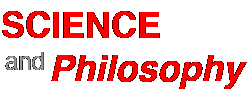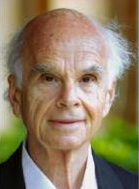Reading on: The systems view of the universe
Laszlo, Ervin, The Systems View of the World, George Braziller, New York 1972 [abridged– 1600 words] [abstract– 420 words] — humans are part of a complex natural self-organizing hierarchy
Imagine a universe made up not of things in space and in time, but of patterned flows extending throughout its reaches. What flows is a mysterious, non-individualized something we call energy. It flows along pathways structured by the metric of integral space-time. It flows smoothly, without crinks or wrinkles, over vast stretches of this cosmic matrix, and it becomes contorted in some regions.
In these regions there are disturbances along the flows induced by the presence of electromagnetic forces. Some of the flows tie themselves into knots and twist into a relatively stable pattern. Now there is something there— something enduring—whereas before there was but a transitory flow. Here and there, energy forms recognizable patterns which endure in time and repeat in space. “Things” are emerging from the background of flows like knots tied on a fishing net. These are local configurations of energies which remain put. The highly integrated focal points of such phenomena are the most basic kinds of energy patterns the human intellect can objectify against the background of space-time. They are the particles of matter; Einstein called them “electromagnetic disturbances” in the space-time matrix.
Let us suppose that there are a vast number of such knots tied across the reaches of space-time, and that these knots are at uneven distances from one another. They form not isolated units but parts of a continuum, and they communicate with one another through the continuum. Their primary mode of communication is attraction and repulsion, depending on the distance separating them from one another. Attraction is the dominant mode of communication at all but extremely close intervals, and thus the knots in relative proximity move closer together. Many of them come to be concentrated in such close quarters that ordinary attraction breaks down and more complex strains and stresses are created between them.
Some of the elementary units achieve cohesion in balancing the energy flows that constitute them in a joint pattern. They constitute “super-knots” of a much more complex kind. A population of such complex entities transforms the character of space-time in the region of their concentration. There arises a material object—a star. These macro-objects continue to be connected through the continuum on which they are superimposed, but now they act as integrated masses: they form complexes constituted by the balance of their joint attractions and repulsions. The relatively stable super-units thus emerging further associate among themselves.
Eventually the entire universe is dotted with balanced knots-within-knots in space-time, affecting each other and reaching further orders of delicate balance. The universe itself takes on the character of a vast system of balanced energies, acting in some discernible form of cohesion… In some cosmic regions—such as planetary surfaces— further processes of structuration occur… And the process continues; the beat goes on. Established structures jointly constitute new pathways and these, becoming established as structures in time, serve as templates for the production of new systems of flows. The patterns become complex; the hierarchy of natural systems grows.
The known entities of science are modules located on various levels of the emerging hierarchy. For example, electrons and nucleons are condensations of energies in space-time field… They are capable of integration into balanced structures maintaining a dynamic steady-state: atoms... [that are] capable of forming bonds with neighboring atoms. We thus get steady-states produced by the integration of the energies of several atoms: chemical molecules. The tremendous potentials of electronic bonding, as well as of weaker forces of association, permit the formation of complex polymer molecules and crystals under energetically favorable conditions.
In some regions, under especially favorable conditions, the level of organization reaches that of enormously heavy organic substances, such as protein molecules and nucleic acids. Now the basic building blocks are given for the constitution of self-replicating units of still higher organizational level: cells. These systems maintain a constant flow of substances through their structures, imposing on it a steady-state with specific parameters. The inputs and outputs may achieve coordination with analogous units in the surrounding medium, and we are on our way toward multicellular phenomena. The resulting structures—organisms—are likewise steady-state patterns imposed on a continuous flow… The organic systems themselves, define the supraorganic (ecological or social) community. Ultimately the strands of communication straddle the space-time region within which the primary systems have come together, and those of its layers which provide conditions favorable to such struc-turation become organized as systems in their own right. We reach the level of the global (ecological, and on earth also sociocultural) system.
If the above is a sketchy but basically valid account of development and relatedness in nature, it is far from flattering for our ego. Once, in his own eyes, man was the center of the universe, the glory of creation. All development tended toward the human form or, in a more static world view, the human being was the highest expression of the genius of the Creator. With the advance of knowledge, man’s central place in the universe was questioned. The sun, regretfully, refused to honor our expectations of serving man by faithfully following its lightgiving path around the horizon; instead, it made our own earth its satellite. The solar system, too, turned out to be somewhat less than the vastest or most majestic creation in the universe— it was discovered to be a rather minor system on the periphery of a galaxy. Those who viewed with alarm the displacement of man from the center of the universe found some comfort in the finding that, if nothing else, at least our galaxy proved to be a large one…
The systems view of nature and man is clearly not anthropocentric, but it is humanistic for all that. It allows us to understand that man is one species of system in a complex and embracing hierarchy of nature, and at the same time it tells us that all systems have value and intrinsic worth. They are goal-oriented, self-maintaining, and self-creating expressions of nature’s penchant for order and adjustment. The status of man is not lessened by admitting the amoeba as his kin, nor by recognizing that sociocultural systems are his super-systems. Seeing himself as a connecting link in a complex natural hierarchy cancels man’s anthropocentrism, but seeing the hierarchy itself as an expression of self-ordering and self-creating nature bolsters his self-esteem and encourages his humanism.
We may not be the center of the universe and the telos of evolution, but we are concrete embodiments of cosmic processes in their particular terrestrial variation. And, albeit accidentally, we did happen to evolve a most remarkable property: self-reflection. In virtue of this we may be among the very few species of natural systems in the universe which are able not only to sense the world and respond to it, but to know their own sensations and come to reasoned conclusions about the nature of the universe. To be a man is thus to have the almost unique opportunity of getting to know oneself and the world in which one lives. It is surely shortsighted to disregard this opportunity and confine oneself solely to the business of living.
A failure to exploit our capability for rational knowledge is, moreover, contrary to the business of living. For our species may not be capable of existing for long without the use of rational insights in guiding its own destiny. Our knowledge has made us increasingly autonomous in nature, and enabled us to create the worlds of culture. It has freed us from many of the bonds of biological existence and given us license to determine our own evolution. But the possibility of error is the price we pay for freedom. The worlds we build for ourselves can be manifold, but they must remain compatible with the structured hierarchy of terrestrial nature. We can build worlds beyond these limits only at our immediate peril. Any such error must be rectified by using the same capacities which originally led to the error: our relative autonomy in nature, conferred by conscious and rational knowledge.
Here is where the integrated natural philosophy of the evolving sciences of our time becomes important. It locates us within the multiple structures of nature and enables us to make constructive use of our large technological capacities. Immersed in the immense hierarchies of the biosphere, we are nevertheless masters of our destiny, for we have enormous control capabilities. As we manipulate the organs and cells of our body through medicines and surgery, so we can manipulate the many strands of social and ecological relations around us. We know fairly clearly what constitutes organic health for our biological system; now we must likewise learn the norms of our manifold ecologic, economic, political, and cultural systems. The supreme challenge of our age is to specify, and learn to respect, the objective norms of existence within the complex and delicately balanced hierarchic order that is both in us and around us. For there is no other way to make sure that we achieve a culture that is viable and humanistic.
The natural philosophy of the new developments in the sciences is a systems philosophy. When properly articulated, it can give us both factual and normative knowledge. Exploring such knowledge and applying it in determining our future is an opportunity we cannot afford to miss. For if we do not, another chapter of terrestrial evolution will come to an end, and its unique experiment with rational consciousness will be written off as a failure.


